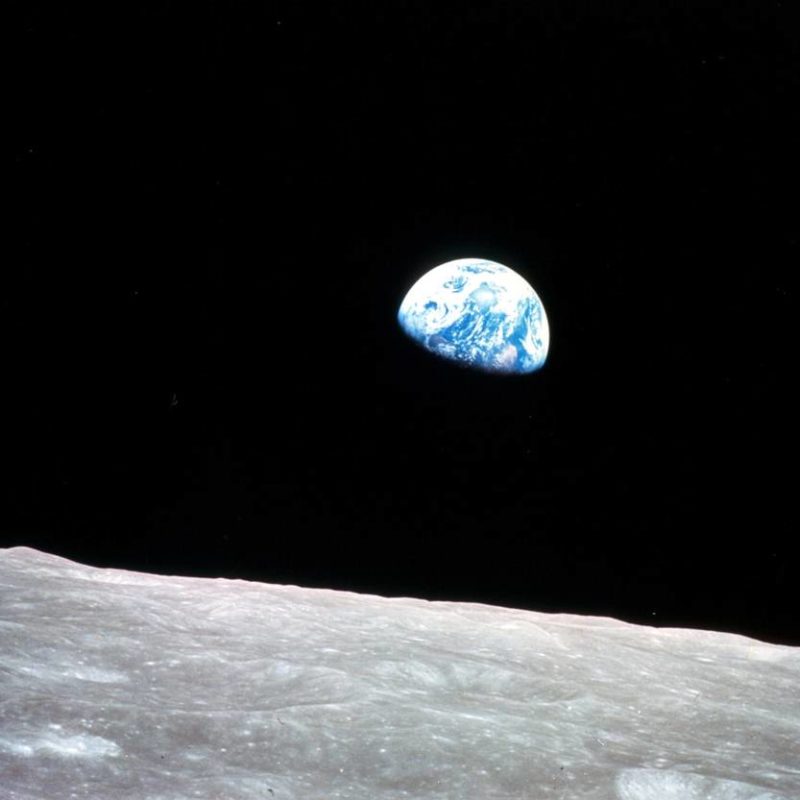As one of “100 photographs that changed the world” and “great images of the 20th century,” Earthrise was shot on Christmas Eve, 1968, when William Anders, Frank Borman, and James Lovell aboard Apollo 8 emerged from behind the moon to behold a sight of extraordinary beauty and meaning.
Anders was the first to see it: “Oh my God! Look at that picture over there! There’s the Earth comin’ up. Wow, is that pretty!” Later, he reflected that though they went up there to study the moon, they came down with an abiding memory of our fair homeworld.
In the well-known Power of Myth series featuring Bill Moyers interviewing mythologist Joseph Campbell, Earthrise was described by Campbell as a mythic image “talking about the planet, not the city, not these people, but the planet, and everybody on it.” He added, “When you see the earth from the moon, you don’t see any divisions there of nations or states. This might be the symbol, really, for the new mythology to come.”
The contrast between these lovely Earthrise visions and the declining health of our planet is deeply disturbing. In a CNN interview in early 2016, astronaut Scott Kelly looked down from the International Space Station and described Earth as seeming “kind of sick…. It definitely looks very, very fragile… like something that we definitely need to take care of.”
It was a state of sickness that prompted the first Earth Day on March 22nd, 1970, after a huge oil spill soaked the coast of Santa Barbara, CA. The dark slick would have been visible from space. The response, Earth Day, was remarkable for its range of support, drawing enthusiasm from Republicans, Democrats, people of every faith, class, and color. It gave us the US Clean Air, Clean Water, and Endangered Species Acts, and led to the founding of the Environmental Protection Agency.
Imagining Earthrise as a kind of beacon shining into collective consciousness allows us to appreciate some of its results: the rise of the environmental and sustainability movements, ecofeminism, ecopsychology, the green building and clean energy movement, a participatory worldview, complexity theory, new discoveries in consciousness studies, and so much more. Psychologically, this signifies a planetary sense of reenchantment: the reenchantment of coming home. And it’s growing.
We can no longer afford disenchantment. We are in trouble, wrote Father Thomas Berry, because we rely on collective stories long worn out. The tellings, images, and worldviews that gave us a significant place in the living world have been flattened by an overemphasis on what is measurable, industrializable, and consumable. This Procrustean rigidity of consciousness is bad for us; moreover, it is bad for Earth and all its remaining creatures.
Earthrise and Earth Day remind us that looking up in hope and reverence aligns with looking down in concern and around with care. Upon a cleansing of vision depends the fate of all earthly species.
The time of reenchantment is upon us, as reflected in so many appreciative remarks by naturalists, environmentalists, ethologists, artists, cosmologists, teachers, writers–and astronauts like IONS’ founder Edgar Mitchell, who exclaimed, “My view of our planet was a glimpse of divinity.”
Craig Chalquist, PhD, is Department Chair of East-West Psychology at the California Institute of Integral Studies, one of IONS’ educational partners. Craig is also President of the Depth Psychology Alliance, and Founding Editor of Immanence: The Journal of Applied Mythology, Legend, and Folktale. Catch up with him at Chalquist.com.
